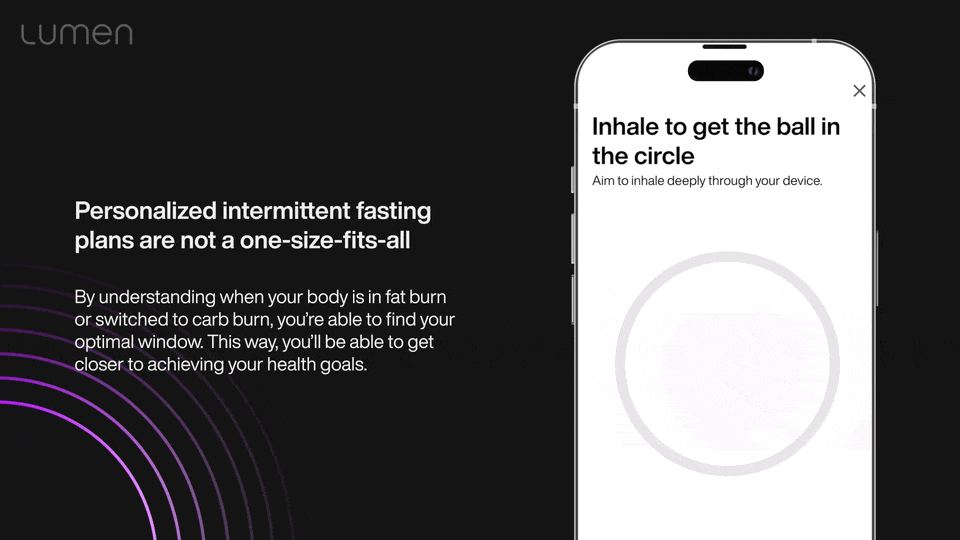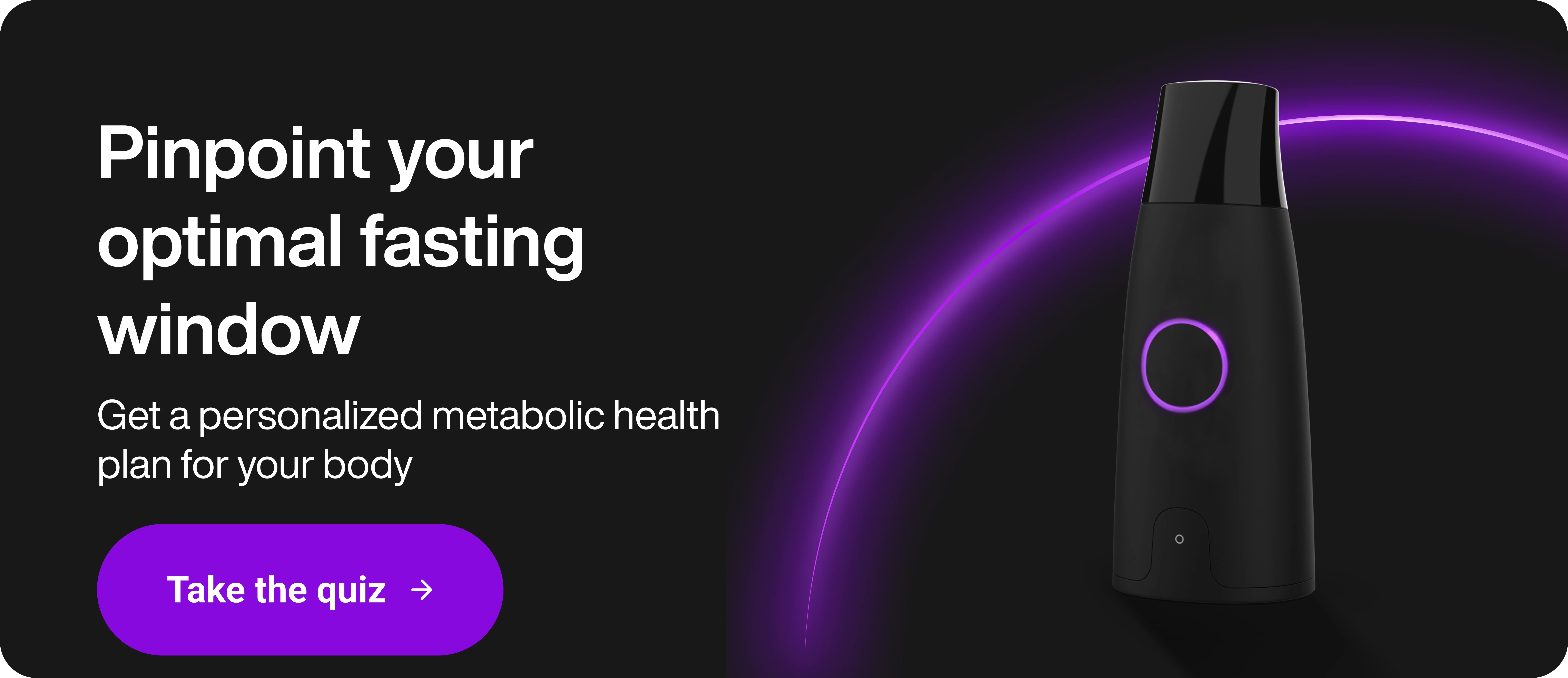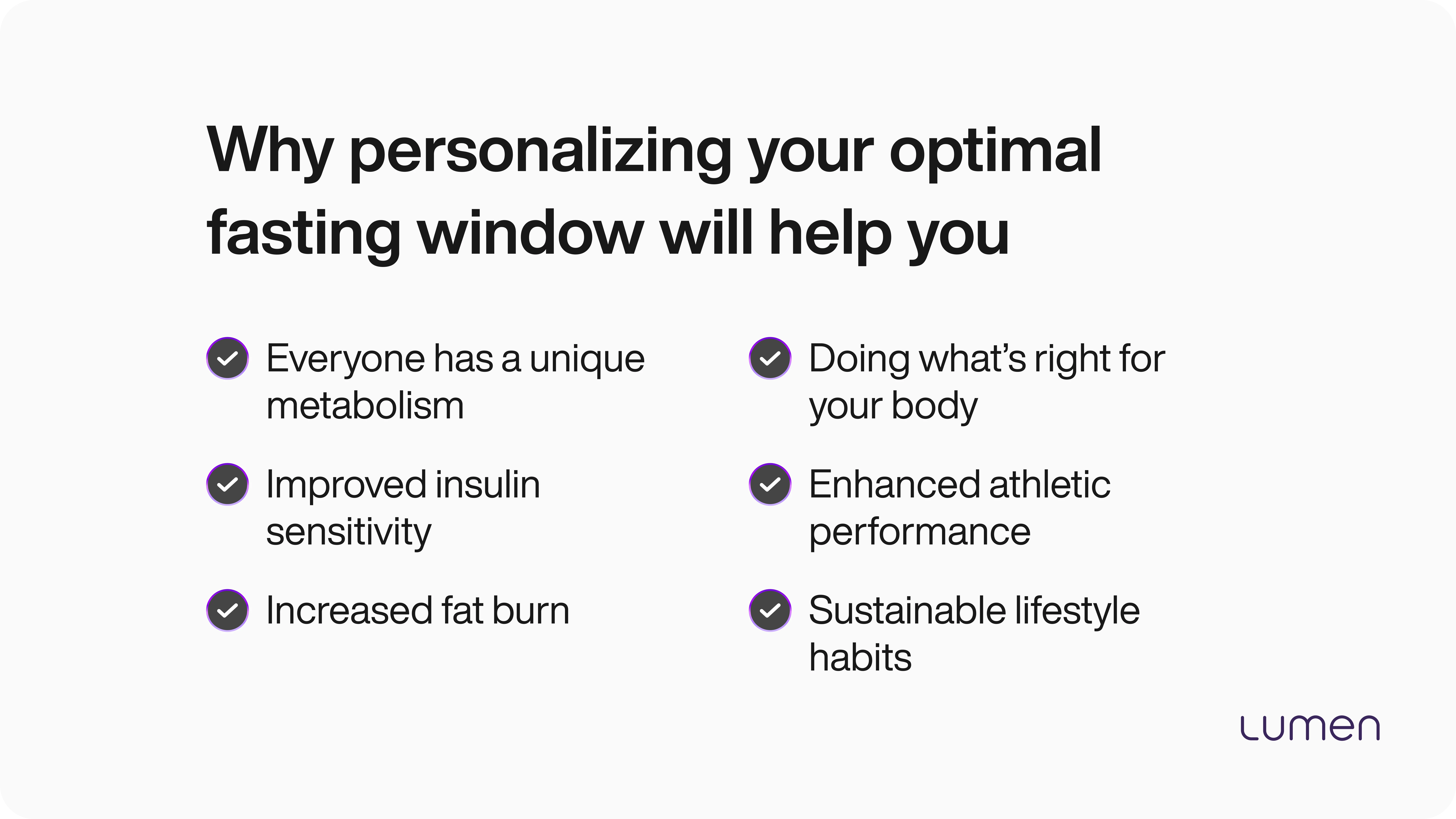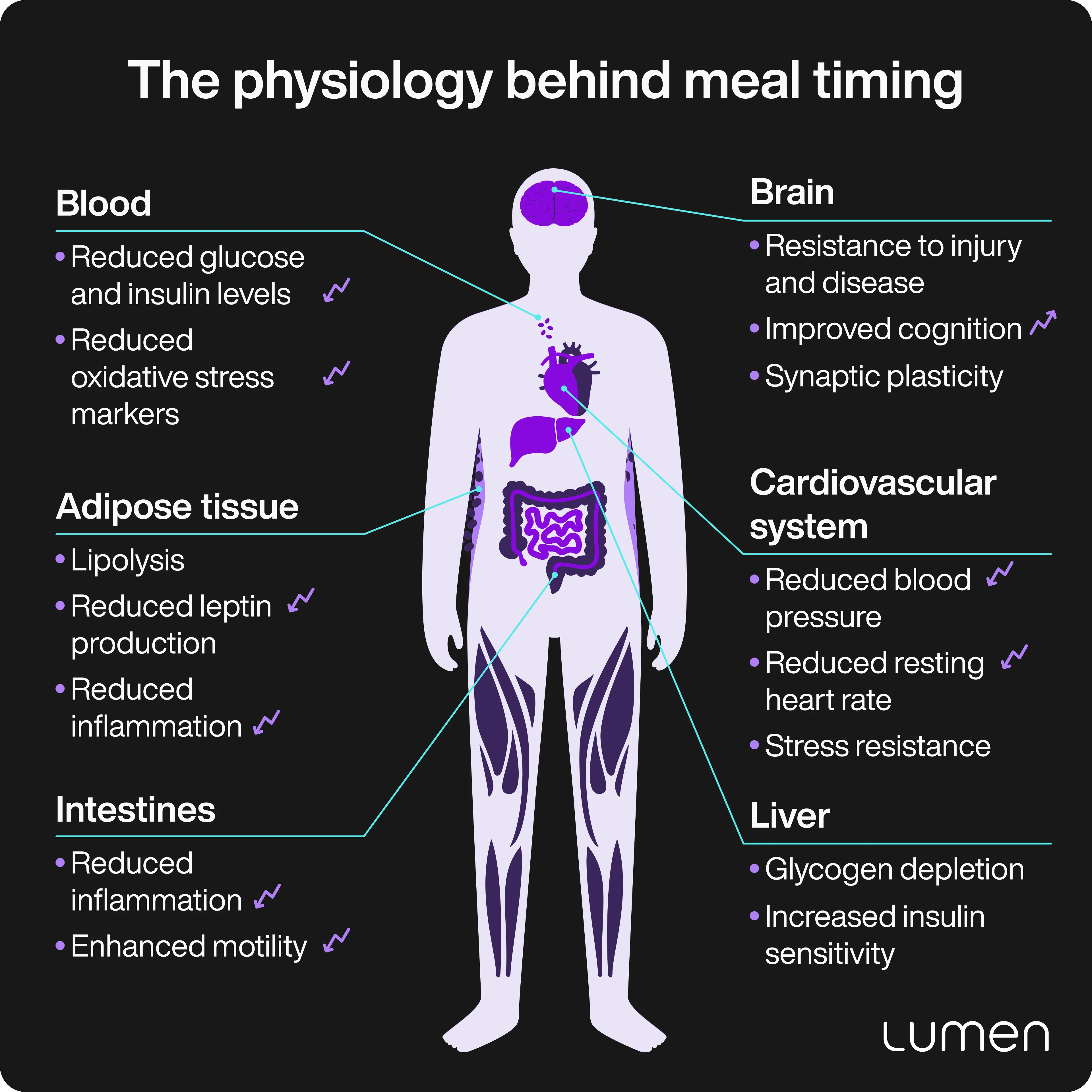How to personalize your intermittent fasting schedule


Have you ever wondered why some people rave about the benefits of intermittent fasting – a regimen that involves fasting and eating for a set amount of time – while others find it challenging and less effective? Could our bodies, like our personalities, have unique responses to fasting?
In today’s digital age, where we seek personalization in everything from shopping to fitness regimens, intermittent fasting shouldn’t be any different. Understanding the nuances of your metabolism, lifestyle, and genetic predispositions can significantly enhance the effectiveness of your intermittent fast.
Since everyone’s body is different, optimal fasting windows will vary for each individual. Research has increasingly highlighted the variation in metabolic responses to different fasting durations [1]. For instance, while one person might find a 14-hour fasting window optimal, another might benefit more from a 16-hour or even an 18-hour fast.
With so many fasting schedules and methods to choose from, selecting the right approach for your body can create a lot of guesswork. However, you can make data-driven decisions about your ideal fasting window by measuring your metabolism.
It’s essential to measure your metabolism when intermittent fasting because when you fast just long enough, your mitochondria, the powerhouses of your cells, burn fat for energy. However, if you extend your fasting window too long and start burning carbs again, it signals muscle breakdown and indicates you should break your fast.
By identifying your body’s unique transitions between fat burn and carb burn, you can reap the benefits of intermittent fasting while avoiding unnecessary stress on your system.
Why does this matter? Understanding your unique metabolism can be the key to successful intermittent fasting, from weight loss and body recomposition to enhanced mental clarity and balanced energy levels.
In this article, we’ll explore the different intermittent fasting schedules and how they can be personalized to help you achieve your weight loss goals.
Research shows that 45% of the world’s population is trying to lose weight, but only 10% tend to keep the weight off long-term. Your body is programmed to hold onto fat as a survival mechanism, so it can take a lot of effort to convince it to let it go. This is why traditional calorie-restrictive diets often fail in the long run—they can slow down your metabolism and make you feel deprived, leading to binge eating and weight regain [2].
Intermittent fasting takes a different approach, working with your body’s natural processes instead of against them. By strategically timing your meals, research suggests you can improve your metabolism and establish healthy eating habits that can lead to sustainable weight loss [3].

One driver of fat loss is reduced caloric intake because intermittent fasters snack less. Another main driver is better metabolic flexibility [4], which is your mitochondria’s ability to easily shift between burning carbs and fats for energy.
During fasting, glycogen, our bodies’ carb stores, becomes depleted. As a result, the body starts breaking down stored fat to use as energy. This increased fat burn directly contributes to weight loss and reduces excess body fat over time [5]. Ideally, your glycogen levels should fluctuate without getting too high or too low. Eating more carbs than you can store as glycogen forces your body to store the excess as fat. At the same time, this overworks your mitochondria, causing oxidative stress that damages their membranes. Plus, chronically high glycogen levels can make your mitochondria overly reliant on carbs and reduce their ability to burn fat effectively.
But you don’t want your glycogen levels to get too low. When you don’t eat enough carbs or fast for too long, your mitochondria won't have the reserves to provide energy boosts, leaving you feeling sluggish. Moreover, constantly relying on fat for energy can make your body less efficient at using carbs, leading to quick weight gain when you eat carbs.
Another benefit of intermittent fasting is that you’ll often align your eating windows with daylight hours, which can enhance your natural circadian rhythm [6]. This synchronization helps regulate hormones such as insulin, which is critical in glucose metabolism.
Late-night screen time or heavy dinners before bed can take you out of sync with the daily rhythm. Confused by an out-of-sync internal clock, your mitochondria work overtime and have less time for self-repair. This can cause you to wake up in a state of carb burn, a sign that your mitochondria are not well-rested. Circadian rhythm disruption can lead to metabolic disorders and weight gain, underscoring the importance of timing your fasting periods to support your body’s natural rhythms [7].
Syncing your eating window with the day-night cycle and maintaining a consistent sleep routine keeps your internal clock in sync. It also gives your mitochondria time for maintenance, repair, and reproduction so they can produce the energy you need.
Brea Lofton, a registered dietitian at Lumen, shares, "By tapping into personalized insights, you can craft a fasting routine that is both effective and sustainable for improving the core of your health, your metabolism.”

What are the different types of fasting?
The most popular intermittent fasting schedules include the 16/8 method, the 5:2 diet, and alternate-day fasting, which we’ll explore in detail below. The one you choose depends on what’s best for your body, and you can find out by measuring your metabolism throughout your fast.
Time-restricted fasting is a type of intermittent fasting that involves limiting the period you eat during the day, usually to a window of 8-10 hours, and then fasting for the remaining 14-16 hours.
During the eating window, you consume all your daily macros and nutrients; during the fasting window, you drink only water or other calorie-free beverages. Some people do this daily, while others follow the regimen a few times a week.

The 16/8 fasting schedule involves fasting for 16 hours and eating within an 8-hour window. Adults of all genders with good health and no underlying medical conditions can typically do 16/8 fasting without issues. However, some people may find it challenging to stick to an 8-hour eating window, especially if they have a busy schedule or social obligations.
Pregnant or breastfeeding women, individuals with a history of eating disorders, and people taking certain medications or with specific medical conditions are not advised to use this fasting schedule.
During 14/10 fasts, you fast for 14 hours and eat within a 10-hour window. During the 14-hour fasting period, you can consume water, unsweetened tea or coffee, and other non-caloric beverages. The 14/10 fasting schedule may be a good starting point for females new to intermittent fasting.
In this fast, the eating window is typically limited to 6 hours, so you have a shorter time frame to eat your meals. This fasting method can be suitable for most healthy adults, regardless of gender or age, as long as they don’t have any underlying medical conditions that may affect their ability to fast.
A 20/4 fasting schedule, or the “Warrior Diet,” involves eating all your daily calories during a 4-hour eating window and fasting for the remaining 20 hours. Listening to your body and adjusting the schedule as needed is very important. Some people find it easier to start with a shorter fasting window and gradually increase the fasting period.
24-hour fasting
24-hour fasting is a type of intermittent fasting that involves abstaining from food for a full 24-hour period. It can be done once or twice a week, depending on individual preferences and goals.
During a 24-hour fast, you consume no calories and may only drink water or other calorie-free beverages. It’s important to note that 24-hour fasting is not suitable for everyone, especially those with certain medical conditions or who are pregnant or breastfeeding.
A 20/4 fasting schedule, or the "Warrior Diet," involves eating all your daily calories during a 4-hour eating window and fasting for the remaining 20 hours. Listening to your body and adjusting the schedule as needed is very important. Some people find it easier to start with a shorter fasting window and gradually increase the fasting period.
Alternate-day fasting is a type of intermittent fasting that involves shifting between days of normal eating and days of either no food or significantly reduced calorie intake. This means that on your fasting days, you might eat a small amount of food or consume no calories, while on non-fasting days, you can eat as you normally would.
The 5:2 fasting approach involves eating at your normal caloric intake for five days a week and limiting calories to 500-600 per day (or roughly 25 to 30% of your normal calorie intake) on two non-consecutive days. This approach may be too restrictive for some people, leading to overeating on non-fasting days.
Intermittent fasting is not a one-size-fits-all. Here are some tips to consider from our Lumen metabolic coaches:
What can I eat during intermittent fasting?
Diet quality is essential during intermittent fasting to ensure metabolic flexibility. Opt for whole foods like lean proteins, vegetables, fruits, whole grains, and healthy fats to ensure balanced nutrition. Staying hydrated with water, herbal teas, and black coffee is also important during fasting.
What is the best intermittent fasting schedule for weight loss?
Any time-restrictive eating method should be personalized to your body and metabolism. Measuring your metabolism during your fast will help you determine when your body shifts to fat burn, signifying a successful fast. When your body shifts to carb burn after several hours of fasting, your body might be entering a state of stress and undermining your best efforts.

Each person’s ideal fasting window will vary, and knowing what works best for you by measuring your metabolism is key for effective fasting. Consider using a metabolic tracker to understand when your body is in fat burn and when it shifts to carb burn so you can break your fast and do what’s best for your well-being.
Remember, the key to successful intermittent fasting is consistency and personalization. This ensures it’s sustainable and tailored to your unique metabolic responses, enabling you to experience the full range of health benefits from intermittent fasting.
For further reading, learn how intermittent fasting can be combined with a carb cycling plan in this guide.
[1] Parr, E. B., Devlin, B. L., & Hawley, J. A. (2022). Perspective: Time-Restricted Eating-Integrating the What with the When. Advances in nutrition (Bethesda, Md.), 13(3), 699–711. https://doi.org/10.1093/advances/nmac015
[2] Pankevich, D. E., Teegarden, S. L., Hedin, A. D., Jensen, C. L., & Bale, T. L. (2010). Caloric restriction experience reprograms stress and orexigenic pathways and promotes binge eating. The Journal of neuroscience : the official journal of the Society for Neuroscience, 30(48), 16399–16407. https://doi.org/10.1523/JNEUROSCI.1955-10.2010
[3] Vasim, I., Majeed, C. N., & DeBoer, M. D. (2022). Intermittent Fasting and Metabolic Health. Nutrients, 14(3), 631. https://doi.org/10.3390/nu14030631
[4] Marko, D. M., Conn, M. O., & Schertzer, J. D. (2024). Intermittent fasting influences immunity and metabolism. Trends in endocrinology and metabolism: TEM, S1043-2760(24)00097-3. Advance online publication. https://doi.org/10.1016/j.tem.2024.04.014
[5] Anton, S. D., Moehl, K., Donahoo, W. T., Marosi, K., Lee, S. A., Mainous, A. G., 3rd, Leeuwenburgh, C., & Mattson, M. P. (2018). Flipping the Metabolic Switch: Understanding and Applying the Health Benefits of Fasting. Obesity (Silver Spring, Md.), 26(2), 254–268. https://doi.org/10.1002/oby.22065
[6] Longo, V. D., & Panda, S. (2016). Fasting, Circadian Rhythms, and Time-Restricted Feeding in Healthy Lifespan. Cell metabolism, 23(6), 1048–1059. https://doi.org/10.1016/j.cmet.2016.06.001
[7] Fishbein, A. B., Knutson, K. L., & Zee, P. C. (2021). Circadian disruption and human health. The Journal of clinical investigation, 131(19), e148286. https://doi.org/10.1172/JCI148286

Marine is a registered dietitian (RD) with extensive experience in clinical nutrition and a deep passion for well-being, health, and metabolism. With her background as a clinical dietitian and private practice owner, Marine has helped patients from diverse backgrounds improve their health through personalized nutrition. Currently, Marine serves as a customer success nutritionist at Lumen, where she provides expert nutrition support to clinics using Lumen’s technology to enhance their clients’ metabolic health. Marine is dedicated to empowering individuals to improve their relationship with food and achieve their health goals.